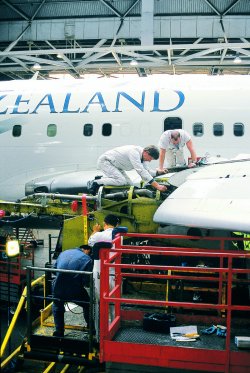Air New Zealand (ANZ) and Qantas have drawn fire over separate proposals to outsource heavy maintenance on long-haul aircraft and engines.
 ANZ has unveiled plans to outsource maintenance on its Boeing 747s, 767s and new 777s starting next year. It is currently in a period of compulsory consultation with its unions over the plan which ANZ estimates will cut 600 jobs, or nearly 30% of its engineers.
ANZ has unveiled plans to outsource maintenance on its Boeing 747s, 767s and new 777s starting next year. It is currently in a period of compulsory consultation with its unions over the plan which ANZ estimates will cut 600 jobs, or nearly 30% of its engineers.
Meanwhile Qantas has raised the spectre of outsourcing widebody maintenance in a prelude to union talks. Chief executive Geoff Dixon says labour’s willingness to make “major concessions” will affect the airline’s decision, slated for early next year. Analysts predict outsourcing could cost more than half the carrier’s 6,900 engineering jobs in Australia.
Neither airline has said where it would send its overhaul work, but both cite the rise of giant maintenance centres in Asia and Europe with their cost advantages for pushing them to consider outsourcing. ANZ also cites excess capacity in its hangars and its inability to attract third-party work. As Rob Fyfe, ANZ’s new chief executive explains, even if ANZ found a partner who needed enough work to keep local engineers busy, “why would you bring it all the way to New Zealand?”
ANZ estimates it will save NZ$100 million ($71 million) over five years by sending maintenance overseas. Qantas is in the second year of a three-year programme to cut costs by A$1.5 billion ($1.1 billion).
Unions on both sides of the Tasman are angry. They are pressing New Zealand’s government, which owns more than 80% of ANZ, to intervene. So far lawmakers have not responded, although one political party insists that Wellington require ANZ to put “people before profits”.
Australian union leaders have called Dixon’s tactics “ruthless”. The engineers union says it will be “flexible” but “we [will not] subscribe upfront to a dollar-driven outsourcing arrangement”.
Most surprising is Dixon’s claim that Australian and New Zealand competition regulators are to blame for ANZ and Qantas needing to outsource. “Had the equity-based alliance [that the two airlines sought] been allowed to proceed,” Dixon says, “600 highly skilled engineering staff in ANZ would be facing a more secure future.”
But the regulators were never asked to consider a stand-alone maintenance joint venture, and if the two airlines had offered such a proposal it probably would have been approved. According to ANZ’s Fyfe, however, even now such a venture would be “sub-scale”.
DAVID KNIBB/BRISBANE
Source: Airline Business























